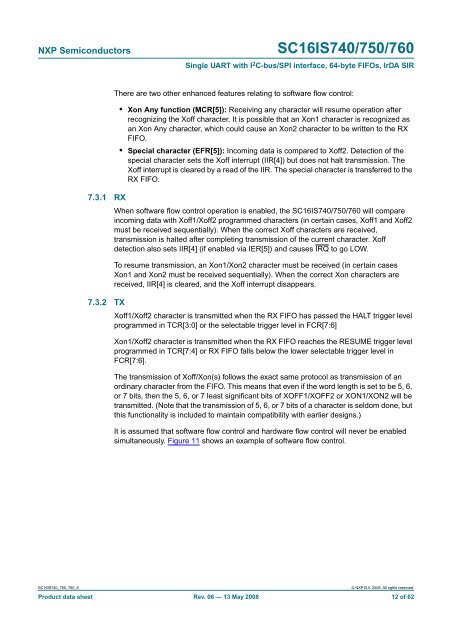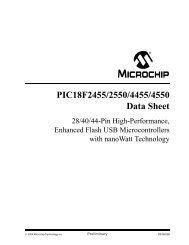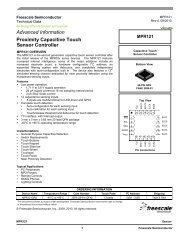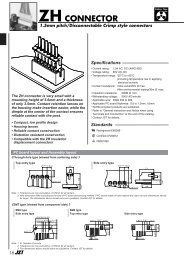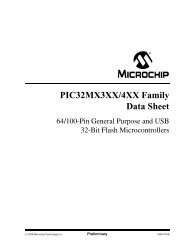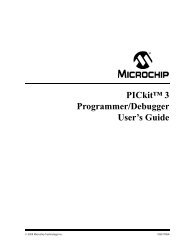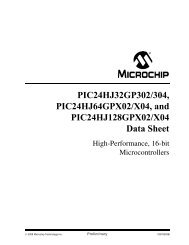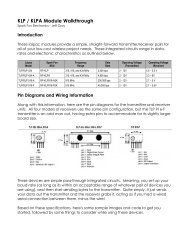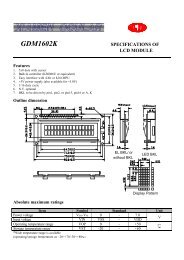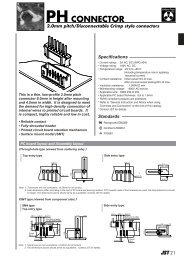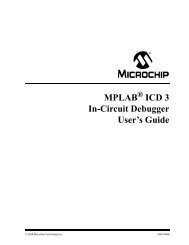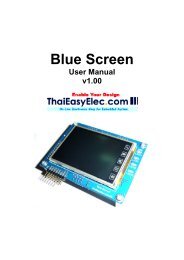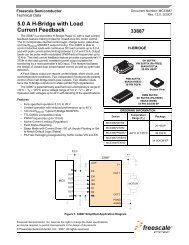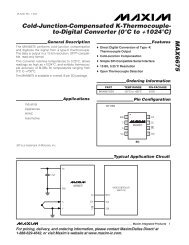SC16IS740/750/760 Single UART with I2C-bus/SPI interface, 64 ...
SC16IS740/750/760 Single UART with I2C-bus/SPI interface, 64 ...
SC16IS740/750/760 Single UART with I2C-bus/SPI interface, 64 ...
You also want an ePaper? Increase the reach of your titles
YUMPU automatically turns print PDFs into web optimized ePapers that Google loves.
NXP Semiconductors<br />
<strong>SC16IS740</strong>/<strong>750</strong>/<strong>760</strong><br />
<strong>Single</strong> <strong>UART</strong> <strong>with</strong> I 2 C-<strong>bus</strong>/<strong>SPI</strong> <strong>interface</strong>, <strong>64</strong>-byte FIFOs, IrDA SIR<br />
7.3.1 RX<br />
7.3.2 TX<br />
There are two other enhanced features relating to software flow control:<br />
• Xon Any function (MCR[5]): Receiving any character will resume operation after<br />
recognizing the Xoff character. It is possible that an Xon1 character is recognized as<br />
an Xon Any character, which could cause an Xon2 character to be written to the RX<br />
FIFO.<br />
• Special character (EFR[5]): Incoming data is compared to Xoff2. Detection of the<br />
special character sets the Xoff interrupt (IIR[4]) but does not halt transmission. The<br />
Xoff interrupt is cleared by a read of the IIR. The special character is transferred to the<br />
RX FIFO.<br />
When software flow control operation is enabled, the <strong>SC16IS740</strong>/<strong>750</strong>/<strong>760</strong> will compare<br />
incoming data <strong>with</strong> Xoff1/Xoff2 programmed characters (in certain cases, Xoff1 and Xoff2<br />
must be received sequentially). When the correct Xoff characters are received,<br />
transmission is halted after completing transmission of the current character. Xoff<br />
detection also sets IIR[4] (if enabled via IER[5]) and causes IRQ to go LOW.<br />
To resume transmission, an Xon1/Xon2 character must be received (in certain cases<br />
Xon1 and Xon2 must be received sequentially). When the correct Xon characters are<br />
received, IIR[4] is cleared, and the Xoff interrupt disappears.<br />
Xoff1/Xoff2 character is transmitted when the RX FIFO has passed the HALT trigger level<br />
programmed in TCR[3:0] or the selectable trigger level in FCR[7:6]<br />
Xon1/Xoff2 character is transmitted when the RX FIFO reaches the RESUME trigger level<br />
programmed in TCR[7:4] or RX FIFO falls below the lower selectable trigger level in<br />
FCR[7:6].<br />
The transmission of Xoff/Xon(s) follows the exact same protocol as transmission of an<br />
ordinary character from the FIFO. This means that even if the word length is set to be 5, 6,<br />
or 7 bits, then the 5, 6, or 7 least significant bits of XOFF1/XOFF2 or XON1/XON2 will be<br />
transmitted. (Note that the transmission of 5, 6, or 7 bits of a character is seldom done, but<br />
this functionality is included to maintain compatibility <strong>with</strong> earlier designs.)<br />
It is assumed that software flow control and hardware flow control will never be enabled<br />
simultaneously. Figure 11 shows an example of software flow control.<br />
<strong>SC16IS740</strong>_<strong>750</strong>_<strong>760</strong>_6<br />
© NXP B.V. 2008. All rights reserved.<br />
Product data sheet Rev. 06 — 13 May 2008 12 of 62


